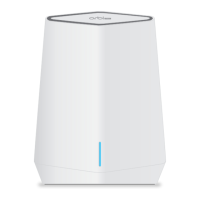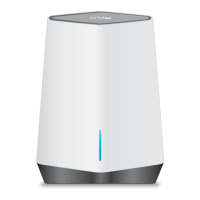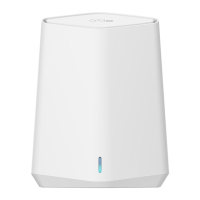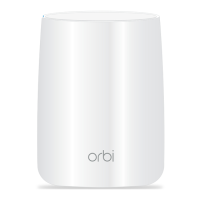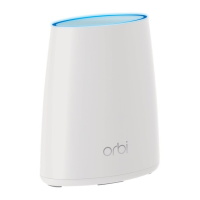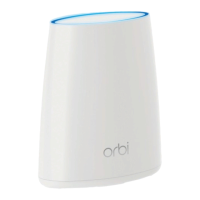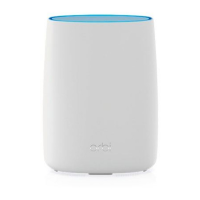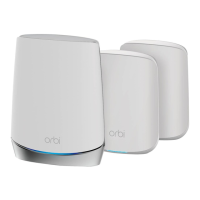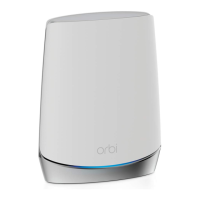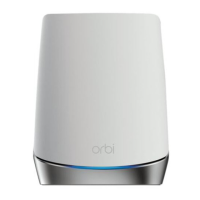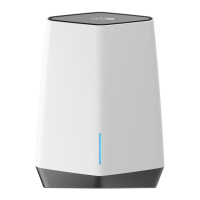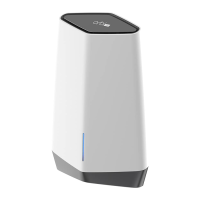
Do you have a question about the NETGEAR Orbi Pro WiFI 6 and is the answer not in the manual?
| WiFi Technology | WiFi 6 (802.11ax) |
|---|---|
| Bands | Tri-band |
| MU-MIMO | Yes |
| Beamforming | Yes |
| WiFi Performance | AX6000 |
| OFDMA | Yes |
| Coverage | Up to 6, 000 sq ft |
| Maximum Data Transfer Rate | 6 Gbps |
| Ethernet Ports | 4 x Gigabit Ethernet ports |
| Security | WPA3 |
| Processor | Quad-Core 2.2GHz processor |
| Memory | 512MB NAND Flash and 1GB RAM |
| USB Ports | 1 x USB 3.0 |
| Number of Devices Supported | Up to 100 |
Lists the Orbi Pro WiFi 6 router and satellite models covered in the manual.
Describes the hardware features of the router (SXR80) and satellite (SXS80).
Explains the meaning of different LED indicators on the router and satellite.
Provides steps for mounting the Orbi Pro WiFi 6 router and satellite on a wall.
Shows examples of router and satellite labels with key information.
Guides on connecting the Orbi Pro WiFi 6 router to your network.
Instructions for positioning and syncing the Orbi Pro WiFi 6 satellite with the router.
Information on using NETGEAR Insight for remote network management.
How to connect a computer to the Orbi network via wired or WiFi for setup.
Details on connecting using Ethernet cable, WiFi network, or WPS.
Explains different login types: Internet service, WiFi network, and router admin.
Instructions on accessing the router's web interface for configuration and monitoring.
Guides on changing the router's display language and handling browser security warnings.
Step-by-step guide to automatically configure Internet settings using the setup wizard.
Instructions for manually configuring Internet connection settings without a login or with a login.
Details on configuring various types of IPv6 Internet connections.
Explains how to adjust the Maximum Transmission Unit (MTU) size for network performance.
How to allow or deny network access based on device MAC addresses for specific networks.
Configure access control for the entire Orbi network based on device MAC addresses.
Set up rules to block specific websites using keywords on a schedule or always.
Exempt a specific trusted computer from website blocking rules.
Control access to specific Internet services (applications, protocols) on the network.
Define schedules for blocking specific Internet sites and services.
Configure the router to send email alerts for security events and router activity logs.
Customize the primary WiFi network name, channel, and VLAN settings.
Secure your primary WiFi network by changing the password and selecting security options.
Set up and manage a separate WiFi network for employees with specific access restrictions.
Configure a dedicated WiFi network for Internet of Things (IoT) devices.
Create a guest WiFi network with open or password access and a custom splash page.
Allocate download bandwidth percentages to different SSIDs to manage network traffic.
Configure advanced WiFi settings like region of operation, SSID broadcast, and coexistence.
Configure Internet connection settings, including DoS protection and ping response.
Adjust the speed settings for the router's WAN port for optimal performance.
Set up a dynamic DNS service to access your network remotely using a domain name.
Configure a DMZ server to improve compatibility with certain applications at the cost of firewall security.
Configure IP addresses, subnet masks, and VLAN profiles for different LAN ports.
Set up the router to automatically assign IP addresses to devices on each LAN.
Assign static IP addresses to specific devices on the network to ensure consistent network identity.
Define static routes for network traffic to specific destinations or gateways.
Enable Universal Plug and Play (UPnP) for automatic device configuration and network access.
Configure VLAN profiles and set Ethernet port modes (Trunk or Access).
Group multiple LAN ports to increase throughput or provide redundancy.
Keep your Orbi system up-to-date by checking and installing the latest firmware.
Secure your router by changing the admin password and enabling a password reset option.
Monitor the router's operational status, system uptime, and network usage data.
Verify the status of your Internet connection and test your network bandwidth speed.
See a list of all devices currently connected to your Orbi network, wired and wireless.
Check the status and connection details of your Orbi satellites via their web interface.
View and manage detailed logs of router activity, security events, and access attempts.
Track and control the volume of Internet traffic passing through the router.
Back up, restore, or erase the router's configuration settings for easy management.
Enable remote access to manage your router's settings over the Internet.
Configure rules to forward specific incoming traffic to servers or applications on your local network.
Set up dynamic port forwarding rules that open ports only when specific outbound traffic is detected.
Configure VPN service and install client software on various devices for secure remote network access.
Establish a VPN tunnel from your computer to access your business network or Internet service remotely.
Basic troubleshooting steps and a recommended sequence for restarting network devices.
Check WiFi and network settings to resolve connectivity issues.
Steps to resolve problems when the router and satellite fail to sync properly.
Solutions for issues preventing login to the router or accessing the Internet.
Diagnose problems with loading web pages and issues with PPPoE Internet connections.
Isolate and resolve issues related to connecting to the Orbi WiFi network.
Use the ping utility to diagnose network path and connectivity problems.
Lists the default factory settings for the Orbi Pro WiFi 6 router and satellite.
Provides detailed technical specifications for the Orbi Pro WiFi 6 router and satellite models.
